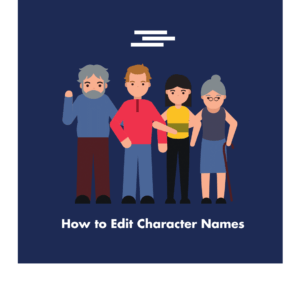
A fiction editor has many responsibilities. One of them is to give a writer the editor’s view of character names.
Character names are a way for readers to connect to the characters and are the first way a writer describes the characters. Inexperienced writers may not put a lot of thought into name choices, and even an experienced writer may not see if they’ve confused a reader with ineffective names.
As an editor, it’s important to create a list of every character in the story, including minor characters. Your goal is to ensure a reader is never confused by the names, can remember a character’s name, and remember the character’s role in the story.
Once you have the list, you’ll review the names and provide suggestions to the writer. The list will enable you to show the writer why your suggestions have merit and also show the writer you are thorough. If you’re confused as the editor, a reader will be confused too. So let’s look at ways character names can cause problems.
Common Problems with Character Names
Too Similar
When reviewing the character list, first look for character names that begin with the same letter. If possible, none of the names should begin with the same letter.
If the character names must begin with the same letter, then recommend that the number of syllables are different and that the names don’t rhyme.
For example, Sidney and Shelly both have start with S and have two syllables. The added problem is both names could refer to a man or a woman. This stands a good chance of confusing a reader. In this case, I would recommend the writer change one of the names.
First and Last Names
First names and last names can be a problem, too. If one character has a first name that is too similar to another character’s last name, this can confuse a reader.
In one of my early drafts, I had two characters. Mike Brown and Constable Miller. The problem occurred in a later scene in the story. Constable Miller was ofter referred to as Miller. In the scene, it was hard to follow who was Mike and who was Miller. My editor recommend I change Mike’s name, so I changed it to Pete.
Referencing Characters Using Different Names
Count how many different ways a writer refers to a character. Inexperience writers may think it adds variety to a story to refer to the same character with different names. Sometimes this must be done to fit the story. If the character is the President, then he’ll be referred to by his title while at work and by his first name while as home with this family.
The issue occurs when a character is referred to as John, Johnny, Mr Smith, Bro, Darling and so on. The reader will lose track of who the character is.
Overuse of Names
Overuse of a character names typically happens in dialogue.
“John, I have something important to tell you.”
“What’s that, Susan?”
This makes dialogue sound stilted. It’s better to use dialogue tags or beats.
“I have something important to tell you,” Susan said.
“What’s that?” John continued to read the book on his lap.
Overuse of Pronouns
Overuse of pronouns is clear when you as the editor lose track of who is speaking. Here, you can recommend the writer add dialogue tags or action beats.
Naming Minor Characters
When a character is named, a reader assumes they will play a role in the story and should make an effort to remember the name. Not all characters need to be named. If the writer has named a minor character, suggest they remove the name as long as it won’t confuse the reader.
Suggestion For the Writer
As final suggestion to the writer, remind them to review their list of names once they have changed any of the names. I’ve had writers who changed a name and inadvertently made it too similar to another character. All they did was move the problem instead of fixing it.
![]()
A Fictionary StoryCoach helps writers tell a powerful story and makes the writer’s voice shine! You can now try Fictionary StoryCoach for editors for free for one month!
And there’s more. The Fictionary Certified StoryCoach training is available.
Do you want to become a Fictionary Certified StoryCoach? Check out Fictionary Certified StoryCoach Training.
If you’d like to take the training, send me (Kristina) an email at helpful.editor@temp-fictionary.flywheelstaging.com telling me why you’d like to become a Fictionary Certified StoryCoach, and I’ll give you a discount.
The Fictionary StoryCoach Certification training program helps editors deliver a comprehensive and objective editorial package using StoryCoach software.
We developed this training for two reasons.
- The first is for fiction editors to have a place to learn how to perform a high-quality story edit, get certified, and then have a tool (StoryCoach) that helps them perform exceptional story edits.
- The second is for writers to know they are dealing with a professional editor who understands story when they hire a Fictionary Certified StoryCoach.
For more on story coaching check out: What is a Story Coach?


